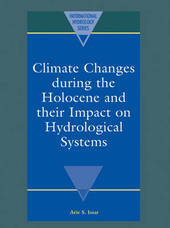
|
Climate Changes during the Holocene and their Impact on Hydrological Systems
Paperback / softback
Main Details
| Title |
Climate Changes during the Holocene and their Impact on Hydrological Systems
|
| Authors and Contributors |
By (author) Arie S. Issar
|
| Series | International Hydrology Series |
|---|
| Physical Properties |
| Format:Paperback / softback | | Pages:144 | | Dimensions(mm): Height 280,Width 209 |
|
| Category/Genre | Meteorology and climatology |
|---|
| ISBN/Barcode |
9780521607735
|
| Classifications | Dewey:551.60901 |
|---|
| Audience | | Professional & Vocational | |
|---|
| Illustrations |
1 Tables, unspecified; 22 Line drawings, unspecified
|
|
Publishing Details |
| Publisher |
Cambridge University Press
|
| Imprint |
Cambridge University Press
|
| Publication Date |
5 August 2004 |
| Publication Country |
United Kingdom
|
Description
It is now widely accepted that increasing concentrations of greenhouse gases in the atmosphere are causing higher global atmospheric temperatures. However, there is still a great deal of uncertainty about the likely effects of such a temperature rise on climate, and even more about the impacts of climate change and variability on the world's hydrological regimes and socio-economic systems. Studying the effects of climate variability in the past can give clues as to possible future effects. This volume provides a comprehensive review of the effects of climate variability on hydrological and human systems in the Holocene (the last 10,000 years), in various parts of the world. The book concentrates on the regions bordering the Mediterranean Sea, western and central Europe, China, Japan, West and South Africa and the southwestern USA. This book will be of value to researchers and professionals in hydrology, climatology, geology and historical geography.
Author Biography
Arie S. Issar is Professor Emeritus at the J. Blaustein Institute for Desert Research, Ben Gurion University of the Negev, Israel
Reviews'This monograph is a very interesting synthesis connecting the hydrological changes in the past with climatic variations and rising human impact.' Leszek Starkel, Hydrological Sciences Journal
|